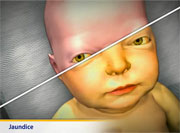
Bilirubin Lights
What are bilirubin lights?
Bilirubin lights (often called “bili lights”) are used to shine a bluish light on a babies’ skin. This helps the baby get rid of bilirubin. Bilirubin is released into the blood when red blood cells break down. The liver uses bilirubin to make bile.
Normally there is only a small amount of bilirubin in the blood. High levels may be caused by liver or blood problems. When the bilirubin level rises, it causes the skin and whites of the eyes to become yellow. This change to yellow is called jaundice.
Bilirubin often builds up to higher levels in newborn babies. Usually this does not cause a problem. However, if a baby and mother have different blood types, sometimes the mother produces antibodies that destroy the newborn's red blood cells. This causes a sudden buildup of bilirubin in the baby's blood. This serious type of jaundice usually begins during the first 24 hours of life.
Although jaundice is usually not harmful, when the bilirubin reaches very high levels, it can damage the brain. It is important to reduce high levels of bilirubin.
How does a bilirubin light work?
The bluish light (sometimes called “phototherapy”) changes the type of bilirubin into a form that is more easily dissolved in water. This type of bilirubin goes out of the body in the urine and stool. The bilirubin level then goes down.
How long will bili lights be used?
The amount of time a baby spends under the bili lights is different for different babies. It depends how much bilirubin is being made and how quickly the liver starts to take care of the bilirubin itself. Some babies are under the lights for a day or less, while others are under the bili lights for several days. If the bilirubin level goes very high and the bili lights cannot bring it down fast enough, a procedure may be needed to exchange the blood high in bilirubin with transfused blood that is low in bilirubin.
Are there any complications of bili lights?
The blue light is safe. A rare baby whose parents have a disorder called congenital erythrocytic porphyria should not be put under bilirubin lights. Rarely a baby under bilirubin lights will develop a color of the skin called bronzed baby syndrome. This problem usually gets better without specific treatment.
Many babies under bili lights will get a little warmer, so some babies need to have their clothing and covers adjusted and drink a little more milk. Some babies may need IV fluids to avoid dehydration.
Babies under bili lights have their eyes shielded from the bluish light to prevent harm to the back of the eyes. Goggles or patches may be used to shield their eyes.
Babies that have been under bili lights have to have their bilirubin level measured intermittently. It is checked by a blood test.
When should I call my baby’s healthcare provider?
Call your baby’s healthcare provider if:
- Your baby is getting a lot more yellow since the last time your baby saw a healthcare provider.
- You have noticed jaundice for the first time.
- The stools are white, pale yellow or light gray.
- Your baby has jaundice and is more than 2 weeks old.
Last modified: 2011-02-10
Last reviewed: 2011-01-07

